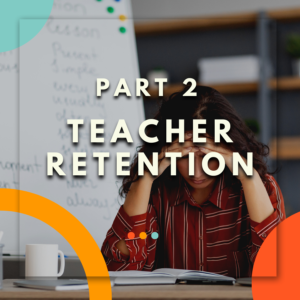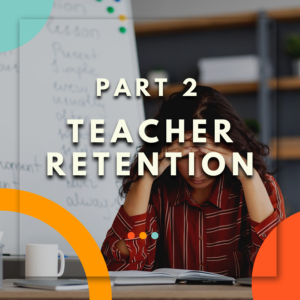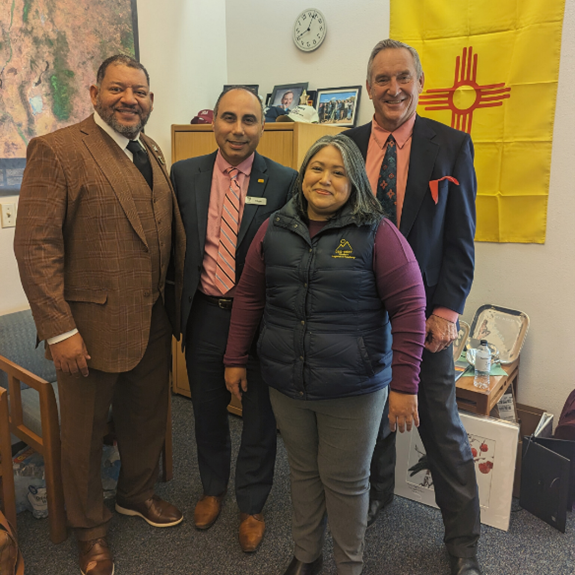The post Private: Criminal Justice Guide to 2023 State of the State Speeches appeared first on CSG Justice Center.
States Addressing the Teacher Shortage, Part 2: Retention
States seeking to solve the teacher shortage, in addition to facing the long-developing crisis of teacher recruitment, are now also facing a crisis of teacher retention.
Especially in the wake of COVID-19, keeping the teachers hired in any given year is an uphill battle.
The National Education Association (NEA) – the nation’s largest teacher’s union – surveyed its members in February 2022 and found that “more than half (55%) of members plan to leave education sooner than planned” and that “the top issue facing educators right now is burnout.”
States across the nation are seeking solutions to improve teacher retention, with research and state examples providing a wide array of options and approaches to choose from. Two key strategies emerging from those examples are:
Supporting career development opportunities through mentoring programs
Improving working conditions for teachers by:
increasing teacher capacity by providing support staff and reasonable class sizes
increasing teacher opportunities to participate in the school decision-making process
supporting administrator training and development
The post States Addressing the Teacher Shortage, Part 2: Retention appeared first on CSG ERC.
States Addressing the Teacher Shortage, Part 2: Retention
States seeking to solve the teacher shortage, in addition to facing the long-developing crisis of teacher recruitment, are now also facing a crisis of teacher retention.
 Especially in the wake of COVID-19, keeping the teachers hired in any given year is an uphill battle.
Especially in the wake of COVID-19, keeping the teachers hired in any given year is an uphill battle.
The National Education Association (NEA) – the nation’s largest teacher’s union – surveyed its members in February 2022 and found that “more than half (55%) of members plan to leave education sooner than planned” and that “the top issue facing educators right now is burnout.”
States across the nation are seeking solutions to improve teacher retention, with research and state examples providing a wide array of options and approaches to choose from. Two key strategies emerging from those examples are:
- Supporting career development opportunities through mentoring programs
- Improving working conditions for teachers by:
- increasing teacher capacity by providing support staff and reasonable class sizes
- increasing teacher opportunities to participate in the school decision-making process
- supporting administrator training and development
Arkansas Looks to Broadband, New Partners to Tackle Rural-Urban Divide in Disability Service Delivery
By Sean Slone, Senior Policy Analyst
Nearly 50 million Americans live in rural areas, where the percentage of people reporting disabilities is highest (17.8%, compared to 12.1% for metropolitan counties). Yet despite the high rate of disability in rural areas, people with disabilities can face significant barriers accessing services and supports, including employment supports. Challenges include long waitlists for Vocational Rehabilitation (VR) services, limited employment options, and lack of transportation and/or broadband to access training and employment opportunities.
Arkansas is one state that has sought to address the challenges faced by people with disabilities living in rural areas and better connect them to employment services, supports, and opportunities. Strategies include expanding broadband access in rural areas, delivering VR services remotely, and leveraging statewide and community partners to better reach individuals with disabilities living in rural areas.
Employment Barriers for People with Disabilities in Rural Areas in Arkansas
A 2021 profile by the University of Arkansas Division of Agriculture identifies Arkansas as one of the most rural states in the country; forty-one percent of Arkansas’ population lives in rural areas, compared with 14% of the U.S. population. According to Jonathan Taylor, Executive Director of the Governor’s Council on Developmental Disabilities, Arkansans with disabilities living in rural areas can face significant barriers to employment in the state. Many experience a four-to-six-month wait to receive VR services, which help them prepare for and attain employment. Once an individual is able to work with a VR client manager, they then struggle finding employment opportunities.
“There are large pockets of the state where in your community, the only employers may be a gas station, a convenience store or a Dollar General,” Taylor said. “In those environments with very low staff, it can be very difficult for somebody with an intellectual or developmental disability to find an environment where they can thrive.”
In addition, there may be limited opportunities for remote work, due to the lack of broadband internet in the state. According to the Federal Communications Commission, only 60% of Arkansans in rural counties live in areas with internet that meets a benchmark download/upload speed. “There are parts of Arkansas where you literally hear that old school dial tone, because that’s all you can get—dial-up [internet]—and it’s unbelievably slow,” said Taylor.
Expanding Broadband and Remote Services and Opportunities
Former Arkansas Gov. Asa Hutchinson devoted significant resources to expanding broadband access in the state. In 2019, he issued a state broadband plan and created a state broadband office that has awarded nearly $400 million in grants to connect rural parts of the state, utilizing federal funding from the American Rescue Plan Act, the Infrastructure Investment and Jobs Act, and other sources. He also worked with the legislature to commission a study of households underserved by broadband.
In addition to connecting individuals with disabilities in rural areas to remote work opportunities, expanded broadband can help them better access VR services. Taylor said the state’s VR agency, Arkansas Rehabilitation Services (ARS), was able to pivot effectively to providing virtual client management during the pandemic. Taylor feels that more virtual interface options for people with disabilities in rural Arkansas can go a long way in solving both their transportation and service delivery challenges. ARS is expected to upgrade its website in 2023 to provide more options for virtual service delivery.
Working With Other Partners to Reach Rural Communities
In their efforts to provide employment supports and services to more people with disabilities in rural areas, state agencies in Arkansas have started to collaborate and blend and braid funding to expand their collective reach. This includes collaboration between ARS and the state’s Provider-Led Arkansas Shared Savings Entity (PASSE) program, which serves Medicaid clients with complex behavioral health, developmental, or intellectual disabilities. ARS is able to share funding with the PASSEs to reach more rural pockets of the state with Pre-Employment Transition Services (Pre-ETS), which provide students with disabilities the opportunity to prepare for and explore the world of work. The sharing arrangement allows ARS, which can offer services in only a limited number of high schools in the state, to extend its reach to serve more people.
Similarly, ARS is working with Easter Seals Arkansas to extend Pre-ETS to rural areas through its SET for Success program in several central Arkansas school districts. As part of the program, trained professionals work with students to help them navigate the post-high school transition period with workplace readiness training, work-based learning experiences, and other initiatives.
Additional Proposed Strategies
State officials see promise in two other strategies to extend service delivery to people with disabilities living in rural areas: engaging people with disabilities directly to better understand their needs and connect them to each other, and collaborating with non-traditional partners such as churches and faith communities to better reach those with disabilities.
Taylor said the Arkansas State Rehabilitation Council has started to engage people with disabilities at a high level to talk about the accessibility of ARS offices and services. However, they’re now considering a more concerted effort to build networks within and among smaller rural communities and to connect the individuals who could benefit from services to each other.
As for faith communities, Taylor believes they could be an answer to helping overcome mistrust of government services in some communities.
“There are more churches than anything else, particularly in the smaller communities,” said Taylor. “I certainly see that as key [to reaching individuals with disabilities in rural areas].”
Considerations for States
Other states have also launched initiatives to help deliver employment and related services to people with disabilities in rural areas.
Colorado Senate Bill 17-011 (2017) created a technical demonstration forum to study solutions to improve transportation access for people with disabilities, including those living in rural areas of the state, with an emphasis on providing adequate access to geographically dispersed jobs.
Hawaii Senate Bill 892 (2015)makes appropriations to expand broadband access, in part to “empower people with disabilities and remov[e] barriers that keep them from participating in everyday activities.”
In Idaho, the Division of Vocational Rehabilitation has collaborated with libraries to establish information and referral procedures for serving individuals with disabilities in rural communities, where VR lacks a physical presence.
From 2015-2017, Montana Vocational Rehabilitation and Blind Services contracted with the Rural Institute for Inclusive Communities at the University of Montana to provide Pre-ETS to students with disabilities.
In July 2020, the Tennessee Department of Human Services published a best practice guide to delivering Pre-ETS virtually. It includes practices for partnering with local education agencies, which can aid in delivering virtual services to those in rural areas.
Wyoming addresses rural transportation access needs for workers with disabilities through regional transportation voucher programs operated by Wyoming independent living centers, Wyoming Independent Living Rehabilitation and Wyoming Services for Independent Living, with funding support from state government.
States Addressing the Teacher Shortage, Part 1: Recruitment
States across the U.S. are considering solutions to address potential teacher shortages. While the extent of the shortage differs from state to state, teacher shortages are most severe in subject areas such as math, science, special education and English language development.
The source of teacher shortages is twofold: waning teacher recruitment and poor teacher retention rates.
In March 2022, the National Center for Education Statistics (NCES) reported that 44% of schools were reporting teacher vacancies. Resignation is the leading cause of vacancies accounting for 51% of reported vacancies, and retirement is reported for 21% of vacancies. NCES Commissioner Peggy G. Carr cites the COVID-19 pandemic as a source for these shortages. Other reports note a variety of factors contributing to declining teacher recruitment and retention, such as working conditions, financial compensation and inadequate preparation and support for new teachers.
As turnover rates increase and recruitment decreases, schools are often forced to increase class sizes while decreasing student supports. In addition, many schools are left to fill vacancies with underqualified teachers, which also contributes to higher turnover rates.
The post States Addressing the Teacher Shortage, Part 1: Recruitment appeared first on CSG ERC.
States Addressing the Teacher Shortage, Part 1: Recruitment
States across the U.S. are considering solutions to address potential teacher shortages. While the extent of the shortage differs from state to state, teacher shortages are most severe in subject areas such as math, science, special education and English language development.
The source of teacher shortages is twofold: waning teacher recruitment and poor teacher retention rates.
 In March 2022, the National Center for Education Statistics (NCES) reported that 44% of schools were reporting teacher vacancies. Resignation is the leading cause of vacancies accounting for 51% of reported vacancies, and retirement is reported for 21% of vacancies. NCES Commissioner Peggy G. Carr cites the COVID-19 pandemic as a source for these shortages. Other reports note a variety of factors contributing to declining teacher recruitment and retention, such as working conditions, financial compensation and inadequate preparation and support for new teachers.
In March 2022, the National Center for Education Statistics (NCES) reported that 44% of schools were reporting teacher vacancies. Resignation is the leading cause of vacancies accounting for 51% of reported vacancies, and retirement is reported for 21% of vacancies. NCES Commissioner Peggy G. Carr cites the COVID-19 pandemic as a source for these shortages. Other reports note a variety of factors contributing to declining teacher recruitment and retention, such as working conditions, financial compensation and inadequate preparation and support for new teachers.
As turnover rates increase and recruitment decreases, schools are often forced to increase class sizes while decreasing student supports. In addition, many schools are left to fill vacancies with underqualified teachers, which also contributes to higher turnover rates.
Binational, bipartisan group of legislators in place to lead Great Lakes Caucus over next two years
With staff support from CSG Midwest, the Great Lakes-St. Lawrence Legislative Caucus works to strengthen the role of state and provincial legislators in advancing Great Lakes-related policies in areas such as controlling the spread of invasive species, protecting drinking water, managing nutrient pollution and improving coastal resiliency.
Leading that work is a select group of legislators serving on the GLLC’s Executive Committee. That leadership team is now in place for the next two years, and includes six new members:
Québec MNA MNA Joëlle Boutin
Ohio Sen. Theresa Gavarone
Michigan Rep. Rachel Hood
Minnesota Sen. Mary Kunesh
Pennsylvania Sen. Daniel Laughlin
Wisconsin Rep. Lisa Subeck
The Executive Committee’s two officers are Wisconsin Sen. André Jacque, GLLC chair; and Illinois Sen. Laura Fine, GLLC vice chair.
In addition to these two officers and the six new members, other legislators from across the Great Lakes basin are returning to serve second terms on the GLLC Executive Committee: Illinois Rep. Sonya Harper, Indiana Rep, David Abbott, New York Sen. Mark Walczyk and Ontario MPP Jennifer French. The Executive Committee also includes three ex officio members, all of whom are past chairs of the GLLC: Illinois Rep. Robyn Gabel, Indiana Sen. Ed Charbonneau and Minnesota Sen. Ann Rest.
The post Binational, bipartisan group of legislators in place to lead Great Lakes Caucus over next two years appeared first on CSG Midwest.
On the Road with CSG West: New Mexico
Two weeks ago, staff from CSG West conducted their annual state visit to the Land of Enchantment. Edgar Ruiz and Martha Castañeda connected with legislators February 7th-9th.
New Mexico’s first session of the 56th Legislature kicked off January 17 and will run for 60 days, until March 18th. As of the halfway point of the session, lawmakers had filed over 1000 bills and other measures. In even years, such as next year’s, the session is limited to 30 days and focused on the state’s budget.
New Mexico is in the enviable position of having a significant budget surplus. Just in the first four months of 2022, more than $1.7 billion were added as a result of oil and gas revenues from the Permian basin. According to the U.S. Energy Information Administration, New Mexico’s Permian basin produces the most oil than any other region nationwide and is second to the Appalachia region in gas production. Recognizing that this windfall is one time money make the budget process tricky for policymakers.
Many of the same issues other states are weighing are on this year’s legislative agenda in Santa Fe. Among them are daylight savings time, gun safety, changes to pretrial detentions, reducing gross receipts tax, reproductive rights, and voting access just to name a few. A bill adding an official state aroma to the list of more than 20 state symbols was getting a lot of attention. Senate Bill 188, sponsored by CSG West legislative liaison Senator Bill Soules of Las Cruces, and has garnered nationwide attention. In this NPR Weekend Edition interview with Scott Simon, Senator Soules explains the idea originated in a fifth grade classroom which invited him in November to learn what it’s like being a state senator. This is civics lesson the kids won’t soon forget, as a handful of the kids from that class at Monte Vista Elementary in Las Cruces spoke in support of the bill in front of the Senate Indian, Rural and Cultural Affairs Committee.
CSG West staff met with many members, both new and others that have been engaged with CSG West over time. The new Speaker of the House, Representative Javier Martinez, who is a 2017 graduate of the CSG Henry Toll Fellowship, was generous with his time in meeting with staff. Speaker Martinez has represented Albuquerque’s House District 11 since 2015 and previously served as Majority Floor Leader.
The Henry Tolls Fellowship Program is named after former Colorado Senator Henry Wolcott Toll, who founded CSG in 1933. The program is one of the nation’s premier leadership development programs for state government officials. Each year, the program gathers 48 of the nation’s top officials from all three branches of state government in Lexington, Kentucky for an intensive five-day “leadership boot camp.”
Staff met with House Minority Floor Leader Ryan Lane who is a 2022 graduate of the Western Legislative Academy (WLA). The WLA was established in 2000 at a time when many Western states had term limits in place. It is open to legislators in their first four years of cumulative service on a competitive basis as there are four slots available per state to fill. The goals of the program are to help legislators become more effective leaders and, in turn, build strong legislative institutions. It’s held in annually in Colorado Springs, Colorado, and includes experts in state legislatures, communications, time and focus management, governance, ethics, and negotiations.
Staff also met with key legislative staff such as the director of the Legislative Council Service (LCS), Raúl Burciaga, who previously served as Chair of CSG West’s Legislative Service Agency and Research Directors Committee.
From Left to Right: Senator Harold Pope, Edgar Ruiz, Martha Castañeda and Senator Bill Soules
The post <strong>On the Road with CSG West: New Mexico</strong> appeared first on CSG West.
On the Road with CSG West: New Mexico
Two weeks ago, staff from CSG West conducted their annual state visit to the Land of Enchantment. Edgar Ruiz and Martha Castañeda connected with legislators February 7th-9th.
New Mexico’s first session of the 56th Legislature kicked off January 17 and will run for 60 days, until March 18th. As of the halfway point of the session, lawmakers had filed over 1000 bills and other measures. In even years, such as next year’s, the session is limited to 30 days and focused on the state’s budget.
New Mexico is in the enviable position of having a significant budget surplus. Just in the first four months of 2022, more than $1.7 billion were added as a result of oil and gas revenues from the Permian basin. According to the U.S. Energy Information Administration, New Mexico’s Permian basin produces the most oil than any other region nationwide and is second to the Appalachia region in gas production. Recognizing that this windfall is one time money makes the budget process tricky for policymakers.
Many of the same issues other states are weighing are on this year’s legislative agenda in Santa Fe. Among them are daylight savings time, gun safety, changes to pretrial detentions, reducing gross receipts tax, reproductive rights, and voting access just to name a few. A bill adding an official state aroma to the list of more than 20 state symbols was getting a lot of attention. Senate Bill 188, sponsored by CSG West legislative liaison Senator Bill Soules of Las Cruces, has garnered nationwide attention. In this NPR Weekend Edition interview with Scott Simon, Senator Soules explains the idea originated in a fifth grade classroom which invited him in November to learn what it’s like being a state senator. This is civics lesson the kids won’t soon forget, as a handful of the kids from that class at Monte Vista Elementary in Las Cruces spoke in support of the bill in front of the Senate Indian, Rural and Cultural Affairs Committee.
CSG West staff met with many members, both new and others that have been engaged with CSG West over time. The new Speaker of the House, Representative Javier Martinez, who is a 2017 graduate of the CSG Henry Toll Fellowship, was generous with his time in meeting with staff. Speaker Martinez has represented Albuquerque’s House District 11 since 2015 and previously served as Majority Floor Leader.
The Henry Tolls Fellowship Program is named after former Colorado Senator Henry Wolcott Toll, who founded CSG in 1933. The program is one of the nation’s premier leadership development programs for state government officials. Each year, the program gathers 48 of the nation’s top officials from all three branches of state government in Lexington, Kentucky for an intensive five-day “leadership boot camp.”
Staff met with House Minority Floor Leader Ryan Lane who is a 2022 graduate of the Western Legislative Academy (WLA). The WLA was established in 2000 at a time when many Western states had term limits in place. It is open to legislators in their first four years of cumulative service on a competitive basis as there are four slots available per state to fill. The goals of the program are to help legislators become more effective leaders and, in turn, build strong legislative institutions. It’s held in annually in Colorado Springs, Colorado, and includes experts in state legislatures, communications, time and focus management, governance, ethics, and negotiations.
Staff also met with key legislative staff such as the director of the Legislative Council Service (LCS), Raúl Burciaga, who previously served as Chair of CSG West’s Legislative Service Agency and Research Directors Committee. Raúl is also a graduate of the Toll Fellows Class of 2012.

From Left to Right: Senator Harold Pope, Edgar Ruiz, Martha Castañeda and Senator Bill Soules
The post On the Road with CSG West: New Mexico appeared first on CSG West.
Southern Pulse Newsletter, February 2023
GREETINGS MEMBERS,
This February the CSG South team has been traveling nonstop across the south to meet members in the thick of their own labor of love: working through the legislative session! We thank our legislators and legislative staffers from Virginia, West Virginia, Missouri, Kentucky, and Mississippi for taking time out of their incredibly busy schedules to meet with us. We can’t wait to sit down with Arkansas, Oklahoma, and North Carolina in the coming weeks!
On February 1st, we officially launched registration for the most anticipated regional conference in the nation. The 2023 Southern Legislative Conference (SLC) will be held over five action-packed days in stunning Charleston, South Carolina, and the registered attendees are already pouring in! Make sure you secure your hotel accommodation and your guest, spouse, and youth spots in one of our many off-site activities. Register here, and be sure to explore the schedule, keynote speakers, and more!
From state visits, one-on-one meetings, policy info requests, and SLC planning, we are proud to showcase the wealth of ways we are here for Southern legislators and staff.
Stay connected and see you soon!
Click here to read Southern Pulse- February 2023
The post Southern Pulse Newsletter, February 2023 appeared first on CSG South.






